-
Countries
-
Data and Analysis
-
Special Focus
-
Crisis Responses

Contact
DTM Yemen, iomyemendtm@iom.int
Language
English
Location
Yemen
Period Covered
Jan 02 2022
Jan 08 2022
Activity
- Rapid Emergency Registration
- Mobility Tracking
IOM Yemen DTM’s Rapid Displacement Tracking (RDT) tool collects data on estimated numbers of households forced to flee on a daily basis from their locations of origin or displacement, allowing for regular reporting of new displacements in terms of estimated numbers, geography, and needs. It also tracks Returnees who returned to their location of origin.
From 01 January 2022 to 8 January 2022, IOM Yemen DTM estimates that 708 households (HH) (4,248 Individuals) have experienced displacement at least once.
Since the beginning of 2022, DTM also identified no displaced households who left their locations of displacement and either moved back to their place of origin or another location.
Between 02 and 08 January 2022, IOM Yemen DTM tracked 578 households (3,468 individuals) displaced at least once. The top three governorates and districts where people moved into/within are:
- Shabwah (274 HH) – Osaylan (231 HH), Bayhan (37 HH), Markhah Al Olya (6 HH) districts. All displacements in the governorate were internal.
- Al Hodeidah (136 HH) – Hays (115 HH), Al Khukhah (21 HH) districts. Most displacements in the governorate originated from Al Hodeidah and Taiz.
- Marib (99 HH) – Marib City (79 HH), Marib (20 HH) districts. Most displacements in the governorate originated from Al Jawf.
Most displacements resulted from the increased conflict in the following governorates and districts.
- Shabwah (276 HH) – Osaylan (232 HH), Bayhan (38 HH), Markhah Al Olya (6 HH) districts.
- Al Hodeidah (119 HH) – Hays (74 HH), Jabal Ras (20 HH), At Tuhayta (11 HH) districts.
- Al Jawf (81 HH) – Khab wa Ash Shaf (81 HH) district.
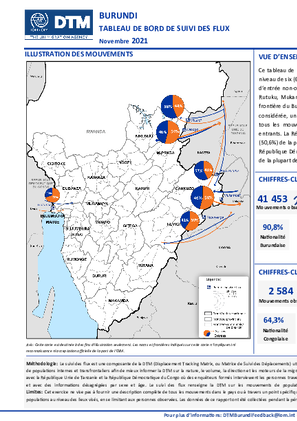
Contact
DTMBurundi@iom.int
Language
French
Location
Burundi
Period Covered
Nov 01 2021
Nov 30 2021
Activity
- Flow Monitoring Survey
- Flow Monitoring
Ce tableau de bord fournit une analyse des tendances de la mobilité des populations observées au niveau de six (6) points de suivi des flux (Flow Monitoring Points, FMP), cinq (5) établis sur des points d’entrée non-officiels établis entre la frontière du Burundi et la République Unie de Tanzanie à Kwa Rutuku, Mukambati, Mbundi, Kabuyenge et Kabogo et un (1) point d’entrée officiel situé entre la frontière du Burundi et de la République Démocratique du Congo à Gatumba. Au cours de la période considérée, un total de 44 037 mouvements ont été observés à ces points. Environ 51,7 pour cent de tous les mouvements au niveau des deux frontières étaient sortants et 48,3 pour cent étaient entrants. La République Unie de Tanzanie était le principal pays d’origine (49,4%) et de destination (50,6%) de la plupart des mouvements suivis à travers les FMPs frontaliers avec ce pays. De même, la République Démocratique du Congo était le principal pays d’origine (30,0%) et de destination (70,0%) de la plupart des mouvements suivis à travers le FMP frontalier avec ce pays.
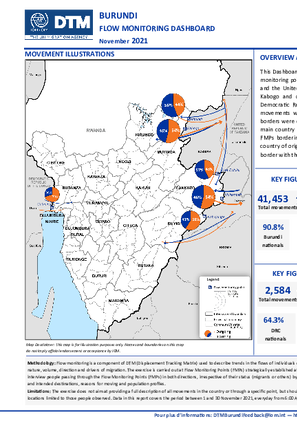
Contact
DTMBurundi@iom.int
Language
English
Location
Burundi
Period Covered
Nov 01 2021
Nov 30 2021
Activity
- Flow Monitoring Survey
- Flow Monitoring
This Dashboard provides an analysis of the trends in population mobility observed at six (6) flow monitoring points (FMPs), five (5) established at unofficial border crossing points between Burundi and the United Republic of Tanzania border at Kwa Rutuku, Mukambati, Mbundi, Kabuyenge and Kabogo and one (1) established at official border crossing point, between Burundi and the Democratic Republic of the Congo at Gatumba. Over the reporting period, a total of 44,037 movements were observed at these points. About 51.7 per cent of all movements at the two borders were outgoing and 48.3 per cent were incoming. The United Republic of Tanzania was the main country of origin (49.4%) and destination (50.6%) for the movements followed through the FMPs bordering this country. Similarly, the Democratic Republic of the Congo was also the main country of origin (30.0%) and destination (70.0%) for movements followed through the FMP at the border with the same country.
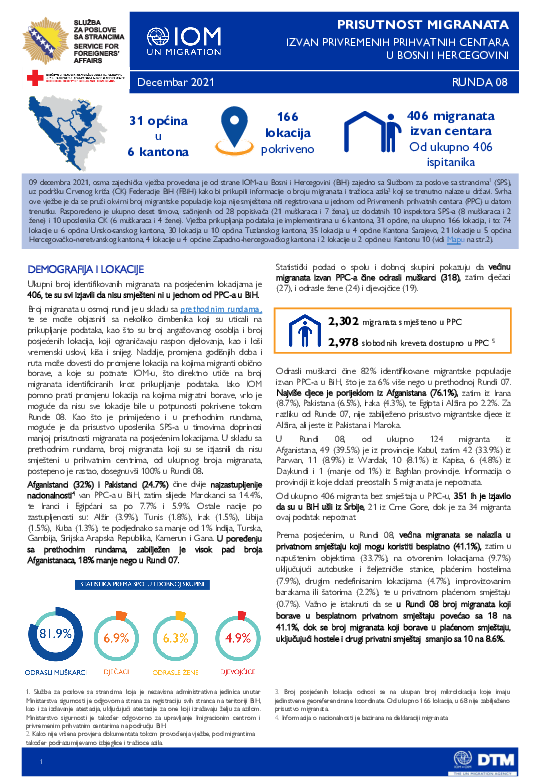
Contact
dtmmediterranean@iom.int
Language
Bosnian, Croatian, Serbian
Location
Bosnia & Herzegovina
Snapshot Date
Dec 09 2021
Activity
- Flow Monitoring
- Migrants presence
09 decembra 2021, osma zajednička vježba provedena je od strane IOM-a u Bosni i Hercegovini (BiH) zajedno sa Službom za poslove sa strancima1 (SPS), uz podršku Crvenog križa (CK) Federacije BiH (FBiH) kako bi prikupili informacije o broju migranata i tražioca azila2 koji se trenutno nalaze u državi. Svrha ove vježbe je da se pruži okvirni broj migrantske populacije koja nije smještena niti registrovana u jednom od Privremenih prihvatnih centara (PPC) u datom trenutku. Raspoređeno je ukupno deset timova, sačinjenih od 28 popisivača (21 muškaraca i 7 žena), uz dodatnih 10 inspektora SPS-a (8 muškaraca i 2
žene) i 10 uposlenika CK (6 muškaraca i 4 žene). Vježba prikupljanja podataka je implementirana u 6 kantona, 31 općine, na ukupno 166 lokacija, i to: 74 lokacije u 6 općina Unsko-sanskog kantona, 30 lokacija u 10 općina Tuzlanskog kantona, 35 lokacija u 4 općine Kantona Sarajevo, 21 lokacije u 5 općina Hercegovačko-neretvanskog kantona, 4 lokacije u 4 općine Zapadno-hercegovačkog kantona i 2 lokacije u 2 općine u Kantonu 10.
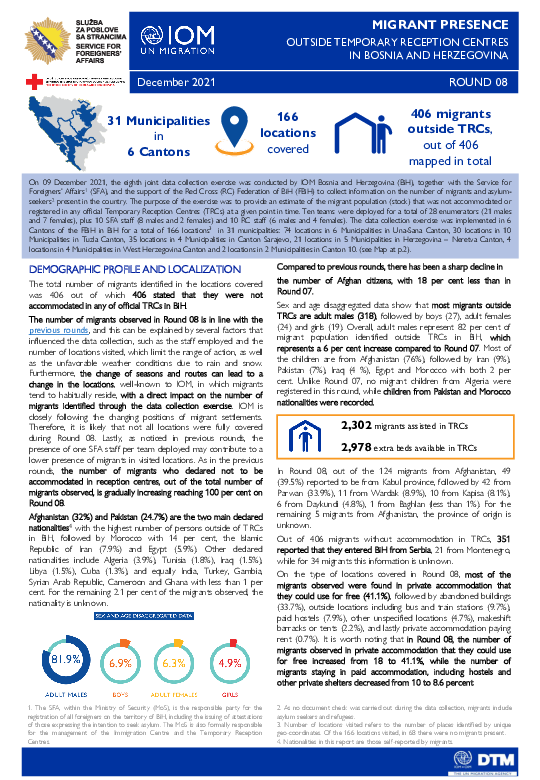
Contact
dtmmediterranean@iom.int
Language
English
Location
Bosnia & Herzegovina
Snapshot Date
Dec 09 2021
Activity
- Flow Monitoring
- Migrants presence
On 09 December 2021, the eighth joint data collection exercise was conducted by IOM Bosnia and Herzegovina (BiH), together with the Service for Foreigners’ Affairs (SFA), and the support of the Red Cross (RC) Federation of BiH (FBiH) to collect information on the number of migrants and asylum seekers present in the country. The purpose of the exercise was to provide an estimate of the migrant population (stock) that was not accommodated or registered in any official Temporary Reception Centres (TRCs) at a given point in time. Ten teams were deployed for a total of 28 enumerators (21 males and 7 females), plus 10 SFA staff (8 males and 2 females) and 10 RC staff (6 males and 4 females). The data collection exercise was implemented in 6 Cantons of the FBiH in BiH for a total of 166 locations3 in 31 municipalities: 74 locations in 6 Municipalities in Una-Sana Canton, 30 locations in 10 Municipalities in Tuzla Canton, 35 locations in 4 Municipalities in Canton Sarajevo, 21 locations in 5 Municipalities in Herzegovina – Neretva Canton, 4 locations in 4 Municipalities in West Herzegovina Canton and 2 locations in 2 Municipalities in Canton 10.
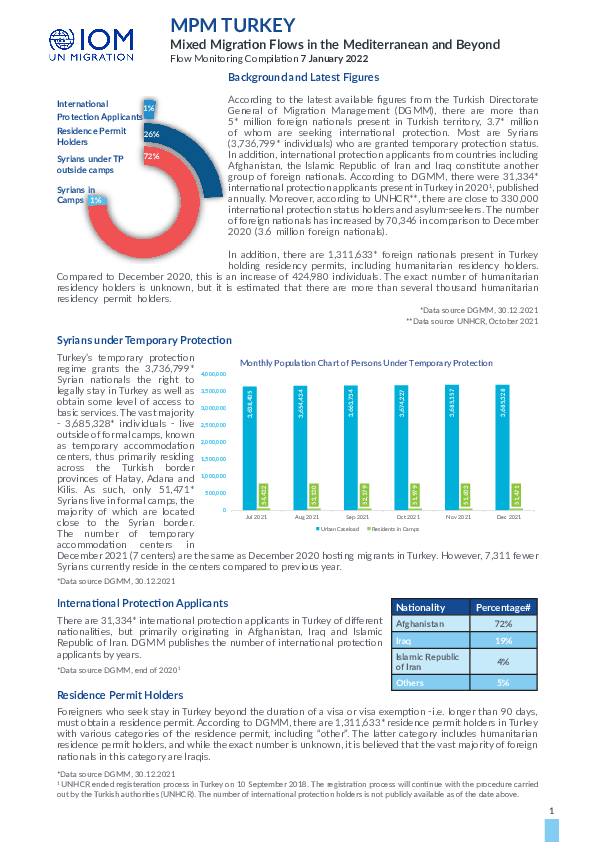
Contact
DTM Turkey, dtmturkey@iom.int
Language
English
Location
Republic of Türkiye
Period Covered
Dec 01 2021
Dec 31 2021
Activity
- Flow Monitoring Survey
- Flow Monitoring
The Turkish Coast Guard (TCG) recorded 2,570* irregular migrants and four fatalities in December 2021. Comparing to December 2020, there is an increase of 1,320 apprehended individuals, when 1,250 irregular migrants were recorded. These figures only include those apprehended and rescued by the TCG, while the actual number of migrants and refugees departing Turkey by sea may be higher.
Apprehensions/Rescues by Turkish Coast Guard Statistics for 2021 (1 January - 31 December 2021): 23,668 irregular migrants
Jan 10 2022
Print
Classification
Thematic focus: To assist IOMs Global Displacement Tracking Matrix (DTM) support team with reporting support and the implementation of quality control mechanisms
Reporting directly
DTM AKO Unit Lead (London) and DTM Lead Editor (London)
Overall supervision
Global DTM Coordinator (London)
Duty Station
London, UK
Number of positions
1
Type
Intern
Closing Date
2022-01-21
Status
Open
Duration
6 months
I. ORGANIZATIONAL CONTEXT AND SCOPE
Since 2004 the Displacement Tracking Matrix (DTM) is IOM’s main operational tool for tracking and monitoring the movements and the evolving needs of displaced populations. It has been systematically deployed in medium to large-scale humanitarian response operations in the last seven years, including in all Level 3 emergencies. During 2021 DTM was active in over 86 countries. To coordinate and support operations implemented by approximately 5,600 staff, the global DTM support team is comprised of 45 specialists across eleven locations (Geneva, London, Bangkok, Nairobi, Dakar, Cairo, Pretoria, San Jose, Buenos Aires, Vienna and The Hague).
As part of the Global DTM Support team, this internship will work part of an active London based team supporting DTM country and regional offices. The position is focused on bringing the quality of analysis and reports regarding displacement and migration to a high standard for external publications. The position is key to ensuring a professional standard to DTMs analysis and reporting which can support operations and advocacy of mobile and vulnerable populations.
Located in the IOM London office, under direct supervision of the DTM Analytics, Knowledge and Output Quality (AKO) Unit Lead (London, UK) and the DTM Lead Editor (London, UK), the successful candidate will integrate into the DTM AKO unit.
III. RESPONSIBILITIES AND ACCOUNTABILITIES
Objective: To provide operational reporting support to DTM Country and Regional offices.
II. RESPONSIBILITES AND ACCOUNTABILITIES
Objective: To provide operational reporting support to DTM Country and Regional offices.
Common to all interns in the AKO unit:
-
Provide support in analysis and interpretation of data, as tasked by the DTM AKO unit
-
Facilitate the logistical organization of webinars in support of the DTM unit to ensure regular internal and external updates on human mobility and displacement;
-
If necessary, in coordination with DTM Country Missions provide updates on human mobility trends, changes and any other significant observations surrounding human mobility and displacement in the respective context;
-
Assist the DTM Country Missions and teams in London in the production and quality control of documents;
-
Coordinate with other units of the global DTM support team to ensure continuity of functional workflows;
-
Provide administrative and logistical support to the London team when needed;
-
Provide support in analysis and interpretation of data as well as in review of DTM documents requiring remote assistance to DTM Missions, at their request;
-
Assist in the refinement of DTM’s data collection methodologies and questionnaires, identifying good practices and providing recommendations for improvement;
-
Support technical training of other staff, including through the organization of dedicated webinars;
Perform any other tasks as assigned.
III. COMPETENCIES
The incumbent is expected to demonstrate the following competencies:
Excellent research, writing, communication and statistical/analytical skills; ability to prepare clear and concise reports; Accountability; Client Orientation; Continuous Learning; Communication; Creativity and Initiative; Planning and Organizing; Professionalism - displays mastery of subject matter; incorporates gender related needs, perspectives, concerns and promotes equal gender participation; Technological Awareness.
BEHAVIOURAL
Strong and demonstrable knowledge and interest in migration, development economics, political economy of development, conflict studies, public health and/or humanitarian issues; personal commitment, efficiency, flexibility; ability to work effectively and harmoniously in a team and with colleagues from varied cultures and professional backgrounds under tight deadlines.
TECHNICAL
Required
- Fluency in French and English at a working professional level
- Proficiency using Microsoft Office 365 (Excel, Word and PowerPoint)
- Experience using Adobe Suite (e.g. InDesign, Illustrator)
- Experience in quantitative research methods
Advantageous
- Experience working with R (programming language), including at least three of the following
- Experience with GIS software such as ArcGIS/QGIS
- Experience with other coding languages (e.g. Python) and relational databases (inc. SQL)
- Experience in qualitative research methods
IV. REQUIRED QUALIFICATIONS AND EXPERIENCE
Education
-
Master’s degree from an accredited academic institution in a field of study related to Economics / Development Economics, Data Science, Political Science, Social Science, Development Studies, Public health, Epidemiology or other relevant disciplines with a significant quantitative component. Alternatively, a Bachelor’s degrees with 2 years of relevant working experience.
V. LANGUAGES
Required
Excellent communication skills in English and French (written and oral)
Advantageous
Knowledge of Arabic and/or additional UN language
VI. ELIGIBILITY CRITERIA
Applicants to the IOM internship programme must, at the time of application, meet one of the following requirements:
a) Be enrolled in the final academic year of a first university degree programme (minimum bachelor’s level or equivalent); or
b) Be enrolled in a graduate school programme (second university degree or equivalent, or higher); or
c) Have graduated with a university degree and, if selected, must commence the internship within one year of graduation.
HOW TO APPLY
Please click here so see full instructions.
NOTE: Candidates without a professional competence in French will not be considered.
Only shortlisted candidates will be contacted.
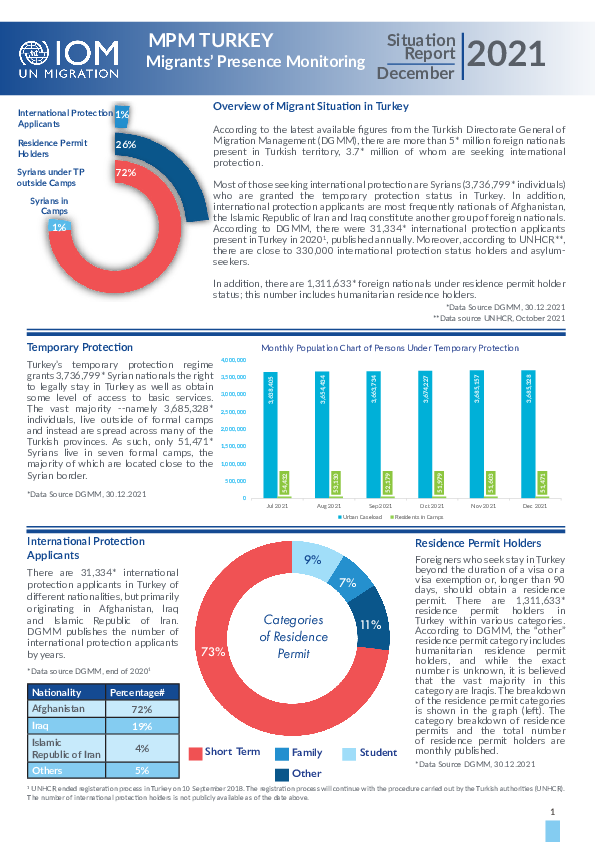
Contact
DTM Turkey, dtmturkey@iom.int
Language
English
Location
Republic of Türkiye
Period Covered
Dec 01 2021
Dec 31 2021
Activity
- Flow Monitoring Survey
- Flow Monitoring
- Migrants presence
According to the latest available figures from the Turkish Directorate General of Migration Management (DGMM), there are more than 5* million foreign nationals present in Turkish territory, 3.7* million of whom are seeking international protection.
Most of those seeking international protection are Syrians (3,736,799* individuals) who are granted the temporary protection status in Turkey. In addition, international protection applicants are most frequently nationals of Afghanistan, the Islamic Republic of Iran and Iraq constitute another group of foreign nationals.
According to DGMM, there were 31,334* international protection applicants present in Turkey in 20201, published annually. Moreover, according to UNHCR**, there are close to 330,000 international protection status holders and asylum seekers.
In addition, there are 1,311,633* foreign nationals under residence permit holder status; this number includes humanitarian residence holders.
*Data Source DGMM, 30.12.2021
**Data source UNHCR, October 2021
Contact
DTM Yemen, iomyemendtm@iom.int
Location
Yemen
Activity
- Event Tracking
- Mobility Tracking
Period Covered
Jan 02 2022 -Jan 08 2022
From 01 January 2022 to 8 January 2022, IOM Yemen DTM estimates that 708 households (HH) (4,248 Individuals) have experienced displacement at least once.
Since the beginning of 2022, DTM also identified no displaced households who left their locations of displacement and either moved back to their place of origin or another location.
Between 02 and 08 January 2022, IOM Yemen DTM tracked 578 households (3,468 individuals) displaced at least once. The top three governorates and districts where people moved into/within are:
• Shabwah (274 HH) – Osaylan (231 HH), Bayhan (37 HH), Markhah Al Olya (6 HH) districts. All displacements in the governorate were internal.
• Al Hodeidah (136 HH) – Hays (115 HH), Al Khukhah (21 HH) districts. Most displacements in the governorate originated from Al Hodeidah and Taiz.
• Marib (99 HH) – Marib City (79 HH), Marib (20 HH) districts. Most displacements in the governorate originated from Al Jawf.
Most displacements resulted from the increased conflict in the following governorates and districts.
• Shabwah (276 HH) – Osaylan (232 HH), Bayhan (38 HH), Markhah Al Olya (6 HH) districts.
• Al Hodeidah (119 HH) – Hays (74 HH), Jabal Ras (20 HH), At Tuhayta (11 HH) districts.
• Al Jawf (81 HH) – Khab wa Ash Shaf (81 HH) district.
Population Groups
Survey Methodology
Unit of Analysis Or Observation
Type of Survey or Assessment
Keywords
Geographical Scope
Administrative boundaries with available data
The current dataset covers the following administrative boundaries

Contact
DTMMozambique@iom.int
Language
English
Location
Mozambique
Period Covered
Dec 29 2021
Jan 04 2022
Activity
- Event Tracking
- Mobility Tracking
During the reporting period (29 December 2021 to 04 January 2022), a total of 21 movements were recorded - 10 arrivals (612 individuals), 3 departures (184 individuals), 4 transits (159 individuals), and 4 intended return movements (107 individuals). The largest individual arrivals were recorded in Mueda (386 individuals) and Meluco (108 individuals). All intended return movements were observed in Nangade, with the largest involving 39 individuals. The largest transits were recorded in Meuda (75 individuals) and Nangade (44 individuals). The largest departures were recorded in Montepuez (180 individuals) and Chiure (4 individuals). Of the total population 24 per cent were displaced for the first time, and 76 per cent of reported IDPs had been displaced more than once prior to this latest movement.